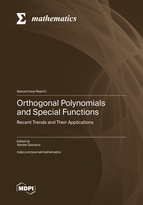Orthogonal Polynomials and Special Functions: Recent Trends and Their Applications
A special issue of Mathematics (ISSN 2227-7390). This special issue belongs to the section "Engineering Mathematics".
Deadline for manuscript submissions: closed (31 March 2024) | Viewed by 21523
Special Issue Editor
Interests: special functions; orthogonal polynomials theory; approximations and expansions; harmonic analysis for orthogonal polynomials expansions
Special Issue Information
Dear Colleagues,
Orthogonal polynomials and special functions are two well-established streams of research in mathematical sciences. As is well-known, these subjects are considered classical, and there exist a large number of very interesting developments of them through the centuries, which are distinguished by an original approach and an in-depth study of the theoretical and/or applied problems considered.
Since orthogonal polynomials and special functions are often driven by applications, these subjects have provided numerous applications to various branches of mathematics, e.g., combinatorics, numerical analysis, representation theory, number theory, and applications to engineering, physics and astronomy, integrable systems, optics, quantum chemistry, computer science, etc. In this way, the number of theoretical and applied problems solved using orthogonal polynomials and special functions is constantly growing.
The aim of this Special Issue is to present recent trends and applications linked to these subjects, mainly those addressed to engineering mathematics and related topics.
Dr. Yamilet Quintana
Guest Editor
Manuscript Submission Information
Manuscripts should be submitted online at www.mdpi.com by registering and logging in to this website. Once you are registered, click here to go to the submission form. Manuscripts can be submitted until the deadline. All submissions that pass pre-check are peer-reviewed. Accepted papers will be published continuously in the journal (as soon as accepted) and will be listed together on the special issue website. Research articles, review articles as well as short communications are invited. For planned papers, a title and short abstract (about 100 words) can be sent to the Editorial Office for announcement on this website.
Submitted manuscripts should not have been published previously, nor be under consideration for publication elsewhere (except conference proceedings papers). All manuscripts are thoroughly refereed through a single-blind peer-review process. A guide for authors and other relevant information for submission of manuscripts is available on the Instructions for Authors page. Mathematics is an international peer-reviewed open access semimonthly journal published by MDPI.
Please visit the Instructions for Authors page before submitting a manuscript. The Article Processing Charge (APC) for publication in this open access journal is 2600 CHF (Swiss Francs). Submitted papers should be well formatted and use good English. Authors may use MDPI's English editing service prior to publication or during author revisions.
Keywords
- orthogonal polynomials
- multivariate orthogonal polynomials
- Sobolev orthogonal polynomials
- multivariate Sobolev orthogonal polynomials
- multivariate Bernstein polynomials, uniform approximation
- Bernoulli polynomials
- generalized Bernoulli polynomials
- Lagrange polynomials
- hypergeometric Bernoulli polynomials
Benefits of Publishing in a Special Issue
- Ease of navigation: Grouping papers by topic helps scholars navigate broad scope journals more efficiently.
- Greater discoverability: Special Issues support the reach and impact of scientific research. Articles in Special Issues are more discoverable and cited more frequently.
- Expansion of research network: Special Issues facilitate connections among authors, fostering scientific collaborations.
- External promotion: Articles in Special Issues are often promoted through the journal's social media, increasing their visibility.
- e-Book format: Special Issues with more than 10 articles can be published as dedicated e-books, ensuring wide and rapid dissemination.
Further information on MDPI's Special Issue polices can be found here.






